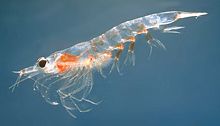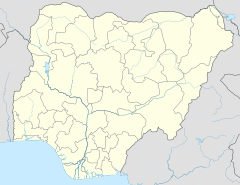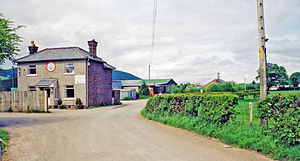유카리다
Eucarida| 유카리다 | |
|---|---|
 | |
| 북부 크릴의 메가니크티파네스 노르베기카 | |
| 과학적 분류 | |
| 킹덤: | 애니멀리아 |
| 망울: | 절지동물 |
| 서브필럼: | 갑각류 |
| 클래스: | 연갑류 |
| 하위 클래스: | 유말라코스트라카 |
| 슈퍼오더: | 유카리다 칼만, 1904년 |
| 주문 | |
유카리다(Eucarida)는 갑각류 아필룸의 일종인 말라코스트라카(Malacostraca)의 슈퍼오더로, 디카포드, 크릴, 암피오니데스, 앙구스티돈티다(Agustidontida)로 구성되어 있다.[2]그들은 모든 흉부 부분에 캐러피스를 융접하게 하고, 스토킹된 눈을 소유함으로써 특징지어진다.[3]
주문
유카리다(Eucarida)는 다양하고 풍부한 집단으로, 다음 네 가지 순서로 구성된다.
유파우시아과
유파우시아아목의 구성원들은 흔히 크릴이라고 불리며, 모두 바다새우처럼 생긴 종으로, 늑막(흉부첨장)이 수영복의 기능을 한다.그들은 떼지어 플랑크톤을 먹고 산다.이 집단은 지구상에서 가장 풍부한 종인 90여 종만으로 구성되어 있는데, 사실 남극 크릴 유푸시아 슈퍼바의 생물총량은 5억 톤으로 추정된다.[4]
데카포다
데카포다는 5쌍의 토라코포드와 아가미(크릴로 노출되는 것)를 덮는 잘 발달된 캐러피스를 가진 15,000종의[5] 종을 가진 집단이다.그들은 바닷가재, 게, 새우, 새우를 포함한다.데카포드는 질구 구조에 기초하여 더 세분화되어 Dendrobranchiata(프론즈)와 Plleocyemata 두 개의 하위주문인 Caridea(진짜 새우), Stenopodidea(박서새우), Anomura, Bracchyura(크랩스) 등과 같은 여러 가지 오버오더로 더욱 세분된다.[6][7]
암피오니다과
또 수수께끼의 유카리드 종인 암피오니데스 레이노우디(Amphionides reynaudi)가 있는데, 이 종은 그 질서의 유일한 대표지만, 크기가 작아서 여러 가지 특징이 없어져 분류가 불분명해졌다.[8]
안구스티돈다목
마지막으로 한 종족인 앙구스티돈테아과만 들어 있는 멸종질서가 있는데, 이 종족에는 앙구스티돈토스와 슈라미돈투스라는 두 종족이 차례로 들어 있다.[9]
필로제니
말라코스트라카 족의 유전학은 논의되고 있다.[6]특히 유카리다의 독신론도 다음과 같은 의문을 받고 있다.
- 단극성: 많은 사람들은 유카리다 집단이 클로데, 페라카리다 집단의[6][10] 자매 또는 기저귀 말라코스트라카에 있다고 주장한다.[7][11]또는 미시다(파라피알레틱 정신분열증)[12]에게
- 파라필레틱: 일부는 중첩된 페라카리다와 쇄골을 형성하는 파라필레틱 유카리다를 제안했다.[13]
- 다혈질: 일부에서는 유파우시아와 미시다를 묶어 정신분열체를 형성하거나,[14][15] 호프로카리다를 포함한 유파우시아스를 페라카리다로 데카포다 기저부를 형성하고 있다.[16][15][16]
참조
| 위키피아는 유카리다와 관련된 정보를 가지고 있다. |
- ^ "Eucarida Calman, 1904". Integrated Taxonomic Information System. Retrieved February 7, 2011.
- ^ WoRMS (2010). "Eucarida". World Register of Marine Species. Retrieved February 7, 2011.
- ^ L. A. Borradaile; F. A. Potts; L. E. S. Eastman & J. T. Saunders (1961). "The Class Crustacea". In Gerald A. Kerkut (ed.). The Invertebrata (4th ed.). Cambridge University Press. pp. 340–419.
- ^ Joel W. Martin; George E. Davis (2001). An Updated Classification of the Recent Crustacea (PDF). Natural History Museum of Los Angeles County. pp. 1–132.
- ^ Sammy De Grave; N. Dean Pentcheff; Shane T. Ahyong; et al. (2009). "A classification of living and fossil genera of decapod crustaceans" (PDF). Raffles Bulletin of Zoology. Suppl. 21: 1–109. Archived from the original (PDF) on 2011-06-06.
- ^ a b c Frederick Schram (1986). Crustacea. Oxford University Press. ISBN 0-19-503742-1.
- ^ a b M. A. Wills (1998). "A phylogeny of recent and fossil Crustacea derived from morphological characters". In Richard A. Fortey; Richard H. Thomas (eds.). Arthropod Relationships. Volume 55 of Systematics Association Series. Springer. pp. 189–210. ISBN 978-0-412-75420-3.
- ^ Richard C. Brusca; Gary J. Brusca (2003). Invertebrates (2nd ed.). Sunderland, Massachusetts: Sinauer Associates. ISBN 978-0-87893-097-5.
- ^ Gueriau, Pierre; Charbonnier, Sylvain; Clément, Gaël (2014-09-01). "Angustidontid crustaceans from the Late Devonian of Strud (Namur Province, Belgium): Insights into the origin of Decapoda". Neues Jahrbuch für Geologie und Paläontologie - Abhandlungen. 273 (3): 327–337. doi:10.1127/0077-7749/2014/0434.
- ^ R. Siewing (1963). "Studies in malacostracan morphology: results and problems". In H. B. Whittington; W. D. Rolfe (eds.). Phylogeny and Evolution of Crustacea. Cambridge, Massachusetts: Museum of Comparative Zoology. pp. 85–103.
- ^ Trisha Spears; Ronald W. DeBry; Lawrence G. Abele; Katarzyna Chodyla (2005). "Peracarid monophyly and interordinal phylogeny inferred from nuclear small-subunit ribosomal DNA sequences (Crustacea: Malacostraca: Peracarida)" (PDF). Proceedings of the Biological Society of Washington. 118 (1): 117–157. doi:10.2988/0006-324X(2005)118[117:PMAIPI]2.0.CO;2.
- ^ L. Watling (1999). "Towards understanding the relationship of the peracaridan orders: the necessity of determining exact homologies". In Frederick R. Schram; J. Carel von Vaupel Klein (eds.). Crustaceans and the Biodiversity Crisis. Proceedings of the Fourth International Crustacean Congress, Amsterdam: The Netherlands, July 20–24, 1998, Vol. I. Brill Publishers. pp. 73–89. ISBN 978-90-04-11387-9.
- ^ Stefan Richter; Gerhard Scholtz (2001). "Phylogenetic analysis of the Malacostraca (Crustacea)". Journal of Zoological Systematics and Evolutionary Research. 39 (3): 113–136. doi:10.1046/j.1439-0469.2001.00164.x.
- ^ Georg Ossian Sars (1870). Carcinologiske Bidrag til Norges Fauna over de ved Norges Kysters forekommende Mysider. Vol. 1. Christiana: Brøgger & Christies Bogtrykkeri.
- ^ a b Simon N. Jarman; Stephen Nicol; Nicholas G. Elliott; Andrew McMinn (2000). "28S rDNA evolution in the Eumalacostraca and the phylogenetic position of krill". Molecular Phylogenetics and Evolution. 17 (1): 26–36. doi:10.1006/mpev.2000.0823. PMID 11020302.
- ^ a b K. Meland; E. Willassen (2007). "The disunity of "Mysidacea" (Crustacea)" (PDF). Molecular Phylogenetics and Evolution. 44 (3): 1083–1104. doi:10.1016/j.ympev.2007.02.009. PMID 17398121.


